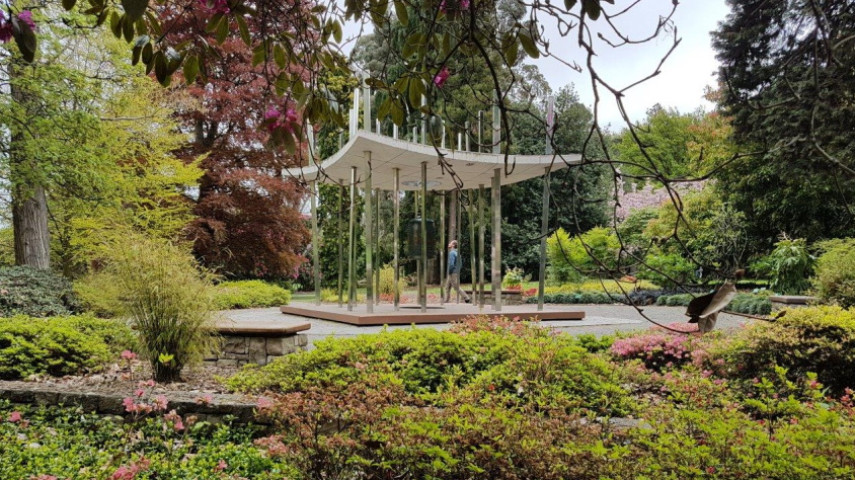The World Peace Bell was gifted to Christchurch by the World Peace Bell Association and unveiled in 2006. It is New Zealand's only peace bell.

In the aftermath of the Second World War the former mayor of Shikoku, Chiyoji Nakagawa, presented the United Nations with a token of peace in the form of a large bell reminiscent of those seen in large temples throughout Japan.
The bell was cast from coins donated by UN member countries, symbolic of the world being one. Unveiled in 1954 at the UN headquarters in New York, the World Peace Bell represents everlasting world peace and a world free from nuclear war.
In 1982, the World Peace Bell Association was formed to continue Mr Nakagawa's goal of promoting world peace with the installation of replica peace bells all over the world.
In 2002 Christchurch was declared the first Peace City in New Zealand. A Peace Bell was gifted to the city by the World Peace Bell Association in Japan.
The Christchurch Botanic Gardens was chosen as the location for the New Zealand Peace Bell. Once the site was blessed by Ngāi Tahu, a raised pavilion was constructed in 2005. The massive 365 kg bell is inscribed with the English 'World Peace Bell' and Japanese 'sekai heiwa no kane'.
The official unveiling took place in 2006 with a ceremony that involved the Christchurch mayor and the World Peace Bell Association founder ringing the bell together. At the unveiling in 2006, Ngāi Tahu gifted Ira Atua Tane, a sculpted piece of pounamu/greenstone, which was placed in the reflection pond beneath the Bell.
In the same year, part of this pounamu - Ira Atua Wahine - was placed under the Te Korowai Rangimarie-Cloak of Peace sculpture (by Kingsley Baird) gifted to the Nagasaki Peace Park by the New Zealand government and six city councils. Now every time the New Zealand World Peace Bell is rung, the pounamu resonates between the two countries.
The New Zealand chapter of the World Peace Bell Association, Te Pere Iha Rakaraka o Te Aio, was instrumental in Christchurch being gifted the bell.
Building strong relationships with their Japanese counterparts, volunteer members visited Japan on numerous occasions to promote the idea of Christchurch receiving the bell as well as fundraising for a bell house and arranging transportation of the bell from Japan to Christchurch.
Today, the organisation administers World Peace Bell events throughout the year.
The World Peace Bell attracts many people, locals and visitors alike, for events and memorials throughout the year and has come to represent a place of serenity and reflection.
Significant community events usually occur on the International Day of Peace in September and the anniversaries of the Hiroshima and Nagasaki bombings in August.
More recently the bell has been rung during the Canterbury earthquake memorials, in remembrance of victims of the Tōhoku earthquake and tsunami, and for Holocaust Remembrance Day.
For more information, visit the New Zealand World Peace Bell website(external link).
You can also stay up to date with events on the New Zealand World Peace Bell Facebook page(external link).
Christchurch has a rich peace heritage including conscientious objection to war, a strong anti-nuclear movement and peace education initiatives.
In March 1982, the city became the first municipality in New Zealand to declare itself nuclear-free and in 2002, the first in the country to be named as a 'Peace City'.
Find out more about Christchurch's peace movements and achievements.
The bell is a prominent icon when entering the Gardens from the daffodil woodlands. Blossom trees corner the pavilion and green lawns with mature exotic trees spread out around it. The pavilion is surrounded by pavers engraved with the word 'peace' in over 40 languages.
Near to the bell sits an attractive grove of Japanese maples (Acer palmatum), a fitting backdrop as maples symbolise peace, serenity and tolerance.
A camphor tree is nearby, the seedling propagated from a camphor that survived the atomic bombing of Nagasaki and was gifted to Christchurch by the late Mayor of Nagasaki, Iccho Itoh.
